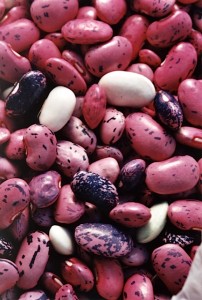“leg-ume – a pod, such as that of a pea or bean, that splits into two valves with the seeds attached to one edge of the valves”.
Recently a friend asked me about beans. She and her family have been following the primal style of eating for months with great success. It’s been a while since they started, so it’s been a while since they read the Primal BluePrint. After a certain amount of time it’s natural for your diet or eating style to move along in a sort of automatic way. You know what to eat so you buy those things and create your daily menu around them. Eventually, you find yourself at the grocery store and you see something like beans and you begin to ask yourself why you aren’t eating beans. You can’t really remember, you just know they aren’t on the menu. If you are anything like me that works for a while but at some point, if I don’t remember the WHY behind a decision I’ve made, I’ll eventually revert right back to what I was doing originally. Beans are a perfect example.
 Beans are not on the menu in my house. They aren’t on the menu in my girlfriends house either. Yesterday, if you had ask either one of us why we don’t eat beans I’m pretty sure we would have said something like, “they’re bad for you”. I don’t think that would convince anyone to reconsider their love of beans. I’m going to try to elaborate on that statement a little for your benefit as well as mine. It’s really important for me to remember the WHY.
Beans are not on the menu in my house. They aren’t on the menu in my girlfriends house either. Yesterday, if you had ask either one of us why we don’t eat beans I’m pretty sure we would have said something like, “they’re bad for you”. I don’t think that would convince anyone to reconsider their love of beans. I’m going to try to elaborate on that statement a little for your benefit as well as mine. It’s really important for me to remember the WHY.
To refresh my memory I re-read the following information: Mark Sisson’s post on Beans/Legumes, I referenced the section on Legumes in my copy of The Perfect Health Diet by Paul & Shou-Ching Jaminet, and finally, I read a post about lentils over at WholeHealthSource.
The first thing I rediscovered was that most everyone lumps legumes and grains together. Basically, everyone goes back to the agricultural revolution and the fact that the human body did not evolve eating legumes or grains and for that reason we, as a human species, do not digest them properly which means they don’t promote optimal health. The information goes on to describe legumes (and grains but I’m going to refer just to legumes going forward) as anti-nutrients. Anti-nutrients interfere with your bodies ability to absorb nutrients. Bad.
Mark Sisson puts legumes in his “o.k. category” with wine, chocolate, cheese and other dairy. What that means is, your diet should be made up of meat and vegetables in order to meet your nutritional needs. You should not rely on legumes for nutrients. Legumes should be a once in a while, lesser benefit food that you eat because you enjoy them. He does explain that the body has difficulty digesting legumes so if you do decide to include them in your diet you need to prepare them properly with a soaking process. A 24 hour soaking process. That right there is what will continue to stop me from eating legumes. I’m not great at planning ahead.
In the book, The Prefect Health Diet, Paul & Shou-Ching Jaminet refer to legumes as “almost-grains”. The “non-grain” legumes that they specifically address are soybeans, kidney beans, lentils and peanuts. Yes, that’s correct. Peanuts are a legume not a nut. Here is a quote from the book:
“Legumes are toxicologically similar to grains. Like grains, they are eaten by herbivores and have developed toxins against mammals, including humans. Important legume toxins include lectins (similar in function to grain lectins like WGA) and alpha-amylase inhibitors (which are also found in grains).”
The Jaminets list leaky gut, bad digestion, diarrhea, bloating, retarded body growth, shrinkage of organs, heart disease and tendon damage as some of the known toxicity effects of legumes. The most typical toxicity effects of legumes are acid reflux and gut bloating. Blah! The other thing to consider is allergies. A couple of the most common allergies are peanut and soybean. One more quote from the book:
“Legumes are so toxic in their raw state – raw kidney beans at 1% of diet can kill rats in two weeks – that they need processing to reduce toxin levels. Traditional methods of reducing toxin levels are soaking, sprouting, boiling, and fermentation.”
Well, that wasn’t good. Let’s move on to what Stephan Guyenet at WholeHealthSource has to say about lentils. He begins by telling us that lentils are a healthy food. They are high protein and lower carb than other legumes and they have lots of vitamins and minerals. Basically his post is about the health benefits of lentils. That’s good. I like lentils (at least I did before I stopped eating them). As you continue to read the post he makes it clear that in order to enjoy the benefits of lentils you must prepare them properly so they are digestible.
“As with all beans and grains, proper soaking is essential to neutralize their naturally occurring toxins and anti-nutrients.”
One anti-nutrient that Stephen Guyenet refers to is phytic-acid. He says that phytic-acid is “abundant” in beans. Here is a quote from WholeHealthSource about phytic-acid:
“It can dramatically reduce the absorption of important minerals such as iron, calcium, magnesium and zinc, leading to deficiencies over time. It may be one of the main reasons human stature decreased after the adoption of agriculture, and it probably continues to contribute to short stature and health problems around the world.”
At the end of the post he gives instructions on how to soak lentils so they can be properly digested when eaten.
O.k., so all of that is pretty interesting but it doesn’t make me think legumes are going to kill me. I feel like I could eat beans/legumes and retain my health as long as I prepare the beans/legumes properly. The Jaminets of the Perfect Health Diet disagree and believe that “legumes are dangerous, and the dangers are not yet fully understood”. I don’t know what your opinion about legumes is, it may fall somewhere between mine and the Jaminets. What I do know is beans are not for me. Proper preparation of legumes is not something I will ever be good at. I’m terrible at planning ahead and quite frankly, it’s just way too time consuming for me. Giving up beans/legumes wasn’t hard. I don’t miss them. I ate them very rarely in the past. I have no need to add them back into my diet. I don’t feel deprived in any way without them.
If you are eating lots of vegetables and “safe” starches along with healthy nutritious sources of animal protein and some fruit I don’t think you need beans. It might be better to stay away from them. If you are a vegetarian then you might need beans. Everyone needs to do what’s right for them. Educate yourself and make the right decision for you.
Here is a link to a website called Living and Raw Foods. Natural Toxins in Sprouted Seeds: Separating Myth from Reality is the article I’m linking to. Toward the bottom of the article there is a paragraph called Anti-Nutrients in Sprouted Legumes. In the paragraph they talk about soaking and sprouting. This is probably good information for those of you that would like to properly prepare beans/legumes. Good luck and enjoy.
Eat Well, Feel Good, Have Fun!

I’m Amy a board certified holistic nutritionist, certified functional nutritionist and lifestyle practitioner and certified Life Coach. I help women in midlife understand the changing needs of their body so that they can stop dieting and lose weight permanently. At 56 I live what I teach. Don’t believe the story that your best years are behind you. They are not. Your best years are just starting!
